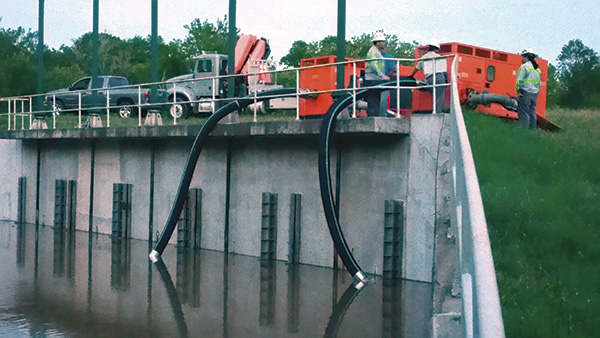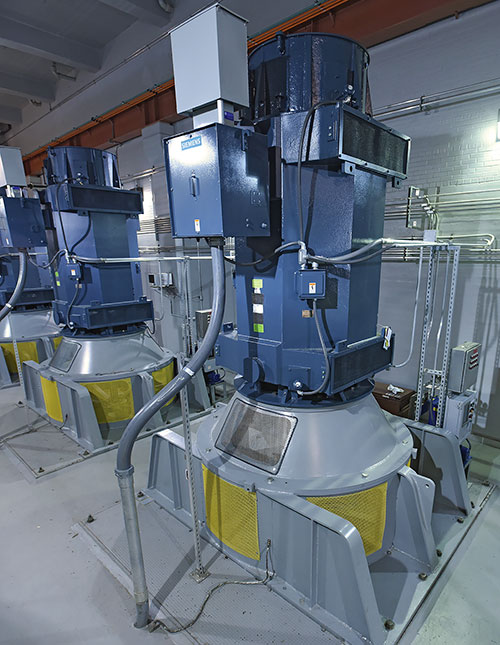In light of the recent record-setting floods in Texas, government entities, companies and individuals have stepped forward to ease the pain of residents and businesses across the ravaged state. Employees of Xylem, with offices in Houston, Dallas, San Antonio and Corpus Christi, acted quickly to support the dewatering needs of local businesses.
 Image 1. According to the NWS, more than 37 trillion gallons of water have fallen in Texas. (Courtesy of Mike McGuff)
Image 1. According to the NWS, more than 37 trillion gallons of water have fallen in Texas. (Courtesy of Mike McGuff) Image 2. 12-inch pumps were deployed to San Antonio and Houston and then in North Texas to fight a series of different storms. (Courtesy of Xylem)
Image 2. 12-inch pumps were deployed to San Antonio and Houston and then in North Texas to fight a series of different storms. (Courtesy of Xylem).jpg) Image 3. The Xylem team spent weeks in June dewatering industry facilities, municipal complexes, parking lots, schools, hotels, and other businesses and areas throughout flood-affected Texas. (Courtesy of Xylem)
Image 3. The Xylem team spent weeks in June dewatering industry facilities, municipal complexes, parking lots, schools, hotels, and other businesses and areas throughout flood-affected Texas. (Courtesy of Xylem) Image 4. NWS declared May the rainiest month in Texas history. (Courtesy of Xylem)
Image 4. NWS declared May the rainiest month in Texas history. (Courtesy of Xylem)MASSIVE PUMPS PROTECT COMMUNITY ON THE FLOOD-PRONE OHIO RIVER

LOUISVILLE, Ky. – There are times and places where pump reliability can be life or death. That's certainly true for Louisville, Kentucky, a city with 1.2 million people that is at the widest and deepest point of the flood-prone Ohio River. The city is haunted by memories of a 1937 flood that put 70 percent of the community underwater, causing $250 million in damage ($3.3 billion in today's dollars) and leaving nine dead in the state of Kentucky.
This wasn't a one-time occurrence. There have been several major floods since then.
To prevent future disasters, the U.S. Army Corps of Engineers (Corps) decided in the early 1950s to build a series of flood control stations. One of these, the Western Flood Pumping Station, was completed in 1952 and equipped with seven massive vertical Peerless-brand pumps. The station protects about 138,000 residents against flooding.
By the first decade of the 21st century, city officials were concerned about continued performance. The pumps, which only activate during routine maintenance or a flood event, were old, powered by electrically outdated synchronous motors and lacked monitoring capabilities. The old pump technology would not work with today's electronic controls. When funds became available for a pump upgrade, officials at the Louisville Jefferson Metropolitan Sewer District (MSD) once again chose Peerless, now a Grundfos brand.
"The goal of the project was to address potential problems before they became critical," says Grundfos Business Development Manager Jeff Lukemeyer.
The station upgrade included seven new vertical mixed flow-line shaft pumps: four with 72-inch nominal diameter bottom casings and 1,250 HP motors, and three with 48-inch casings and 450 HP motors – a combined pumping capacity of a million gallons per minute.
The project took four years from start to finish–two years for design, one for manufacturing and one for installation.
"With the new pumps and controls, the MSD can constantly monitor pump performance," says Lukemeyer. "This is a big benefit. If the pumps don't work when needed, a lot of homes and businesses will be destroyed. Thanks to the ability to fully monitor the station, the operator can make sure the pumps are working correctly at all times."

